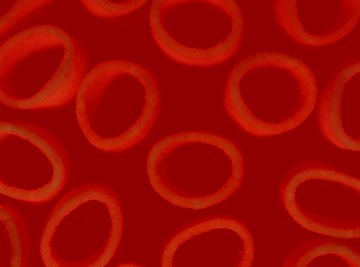
The first adjective people generally use to describe blood is “red.” Haemoglobin, or simply hemoglobin, is the protein molecule responsible for making blood red. Named by combining the Greek word for blood -- haima -- with the idea of globs, hemoglobin is like a little blood blob, explains the Royal Society of Chemistry. In red blood cells, hemoglobin is responsible for the transport of oxygen.
A Story of Discovery
The protein was discovered in 1840 by Friedrich Ludwig Hunefeld, a member of the German Biochemistry Association, according to "Lehninger Principles of Biochemistry" by David Nelson and Michael Cox. This discovery was made while viewing the blood of an earthworm. Pressed between two glass slides, the blood was allowed to dry and crystallize. Hunefeld reported, “I have occasionally seen in almost dried blood, placed between glass plates in a desiccator, rectangular crystalline structures, which under the microscope had sharp edges and were bright red." These structures were hemoglobin. This molecule and other molecules with similar function and structure are found in nearly all vertebrates, many invertebrates -- like earthworms, as well as some plants and fungi.
References
About the Author
With degrees in biology and education, Jennifer VanBuren now utilizes her research and instructional skills as a writer. She has served as educational columnist for "Austin Family Magazine" for four years and also reports on area businesses for "Faces and Places" magazine.
Photo Credits
Creatas/Creatas/Getty Images
